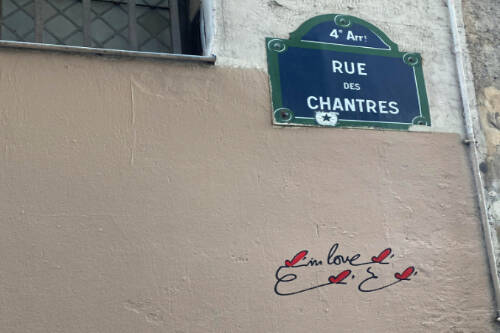Yet the most dear but not
The least cruel of all our memories,
The summer rain,
Sudden, brief.
–Yves Bonnefoy
OK, kids, gather ‘round. Auntie Jane has a story. And it’s one of her favorites, a sad and beautiful story from a long time ago, almost a millennium.
In Paris, walking along the quay at the northeastern edge of the island in the Seine where Notre Dame stands, we come to a building with a plaque identifying it as the home–the “ancienne habitation”–of the 12th-century lovers Héloïse and Abelard, whose lives were ruined by Héloïse’s malignant uncle, the Notre Dame clergyman Canon Fulbert.
But this is not the place. The plaque’s placement here is no doubt for the sake of tourists along this well-traveled boulevard. But Héloïse and Abelard lived around the corner on a smaller, quieter, less-frequented byway. Off to the right of the building with the plaque, we take some steps down to a small empty street, the rue des Ursins, the street of urchins. (In the 10 years since I first discovered it I’ve never seen anyone else there, urchin or otherwise.)
Veering to the left brings us into a narrow alley called the rue des Chantres, the street of singers, where one wall bears a concise graffiti testament of more recent lovers, four red hearts flitting like butterflies around two simple words in English:
“in love.”
The alley leads to the rue Chanoinesse, the street of canons, where a left turn brings us to No. 10. In the early 12th century, this was the location of the home of Canon Fulbert. And that’s where Héloïse and Abelard lived.
This is where the story gets good.
Fulbert had taken into his home his precocious niece, Héloïse, for the purpose of getting her properly educated. (In this respect, at least, old Fulbert seems ahead of his time in wanting to educate a young woman.)
To tutor Héloïse, Fulbert hired (and provided room and board for) Peter Abelard, the brightest young academic star of Paris, a logician whose abilities were putting all his elders to shame. (In fact, in my writing seminars I talk about some of Abelard’s still valid insights into the nature of logic.)
I’m making this story longer than need be, so I’ll cut to the chase, or chase to the cut, as is indeed the tragic case here.
Héloïse and Abelard fell in love. (Who didn’t see that coming?) (I mean, besides Fulbert.) Héloïse got pregnant, so the two lovers ran off and got married in secret (in secret at Héloïse’s insistence, because marriage would have ruined Abelard’s academic career, since everyone knows that professors don’t have time for things like spouses and children and the appurtenant domestic duties).
During this time, Héloïse bore them a son, whom they named Astrolabe.
Upon their return to Paris, Fulbert accused Abelard of raping and abducting his niece. One night he had a couple of thugs break into Abelard’s room and cut off his testicles.
(If you ask me, naming a child Astrolabe is itself grounds for castration, but I’ll let it go.)
After this, Héloïse gets sent off to a convent where she becomes a nun, eventually a very high-ranking nun, an abbess. Abelard leaves his once-promising career as a professor of logic and runs off to a monastery where he spends the rest of his life as a monk getting in trouble with abbots, bishops and popes — all the 12th-century ecclesiastical powers-that-be.
But this is where the story gets beautiful.
Fifteen years go by. Héloïse and Abelard are widely separated by time and space, each at different abbeys distant from each other. But their paths cross in the mail when Héloïse reads a copy of Abelard’s short autobiographical essay, “The History of my Calamities.” She writes him a letter, and they begin corresponding.
In the first letter to her erstwhile husband, Héloïse declares “I don’t care if history remembers me as anything other than Peter Abelard’s whore.”
Not the kind of sentiment you generally hear from a nun.
But she writes Abelard a series of letters that are beautiful for their insights about marriage, about philosophy, about how to endure calamities. Abelard writes back with some hints on how to run a convent.
(Seven letters between them have come down to us across the centuries, and Héloïse’s are some of the brightest literary stars in the medieval firmament. Read them, if you get a chance. Or for just a taste of what they’re like, read Alexander Pope’s poem, “Eloisa to Abelard.”)
What seems most modern about Héloïse’s letters, she recognizes that experience has a truth that logic and science and even philosophy and religion have little access to, a truth that is existential rather than preceptive or didactic, and immediate rather than systematic.
A truth we live, rather than live by.
That’s the truth these columns try to get at. It’s a truth we find in poetry, like the lines from Yves Bonnefoy that begin today’s column. But I’m not a poet, so I have a hard time expressing it. But I will keep trying.
• Jane Hale lives in Juneau with her partner and their two dogs. “Coming Out” appears biweekly on the Empire’s neighbors page.

